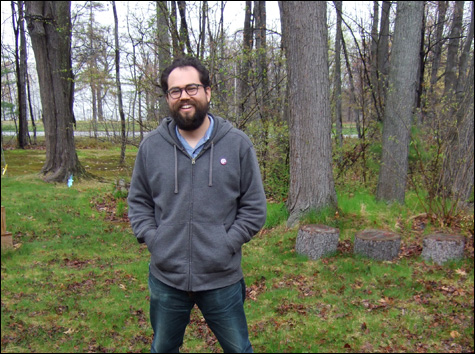
Ron Harrity |
If you have the good sense to attend the “coming out party” for Peapod Recordings at SPACE Gallery on May 9, you’ll get a chance to see the label's puppetmaster, Ron Harrity, in his element — or perhaps just outside it.As guitarist for Honey Clouds, a new local band with a hefty pedigree (Harrity and frontman Trey Hughes were part of the dearly departed Harpswell Sound; bassist Mandy Wheeler cut her teeth in Diamond Sharp), Harrity fails miserably at avoiding the limelight.
Invariably spaced a few extra inches away from the rest of the band, he humbly holds court over a tidy array of colorful effects pedals that lend the band’s droll indie rock a propulsive kick. Spending most of a Honey Clouds set looking down at his fretboard, it’s immediately obvious that Harrity is the band’s resident geek, and its secret weapon.
Harrity’s efforts running the budding local record label — recording, promoting, and often designing and performing on releases by nine bands so far — confirm it. Peapod Recordings shares many commonalities with current trends in DIY art, prevalent on the Web-site-meets-craft-fair Etsy, music blogs, and even other local record labels (Time Lag Records and L’Animaux Tryst (Field) Recordings chief among them): function is favored over cost, quality and care over wide accessibility; a sleek and simple Web site, with easy access to affordable electronic purchases; releases are promoted to niche blogs and magazines that cater to each band’s likely audience, rather than to the mass media at large.
Most importantly, the albums sound beautiful. In contrast to many professionally recorded local releases, which favor a radio-friendly sheen that often betrays an artist’s live strengths (and, worse, their personality), Harrity’s work has a natural warmth and emotional clarity that complements the musicians he works with. As diligent as he is in the studio, Harrity’s albums sound like the work of an invisible hand, and it’s apparent that he likes it that way.
Covert beginnings
His work as a sort of phantom recorder started early.
“I used to hold my dad’s cassette recorder up to the TV when I was in grade school to record songs off of MTV,” Harrity says. “I also used to hide tape recorders under blankets and stuff at notable family get-togethers.”
From there, in the late ’80s and early ’90s, it was DIY sessions with a high school punk band in Kansas City and solo bedroom recordings in Baltimore. Harrity first began releasing properly recorded music after forming Nord Express with his friend, guitarist Rob Goldrick (Harrity played drums), in 1993.
The duo recorded repetitive, dreamy songs on a “stupid-expensive Yamaha 8 track cassette portastudio” that “isn’t worth $100 today,” but were persuasive enough to gain Nord Express a slot on the Berkeley label Slumberland, one of a few quintessential ’90s indie guitar-pop labels. Some of the band’s earlier recordings can be heard on Loveland 1995-2005, an odds-and-ends compilation of the band’s work released on Peapod last year.
Nord Express’s two Slumberland LPs were recorded in the mid-’90s on a 24-track ADAT, or Alesis Digital Audio Tape, a “kind of revolutionary technology,” Harrity says, and they taught him “how good sounding records could be made on the cheap.” (Alanis Morrissette’s 1995 smash, Jagged Little Pill (Maverick/Reprise), was one of the first major albums recorded with ADATs.)
Harrity moved to California in 1997 and continued to play music, but also began taking recording more seriously as a craft. “I immersed myself in recording textbooks and collections of interviews with engineers,” he says, citing work by Steve Albini (who has engineered more than 1000 albums, notably ones by the Pixies, Nirvana, and more recently, Joanna Newsom’s Ys) and Bob Weston (Mission of Burma, Polvo). They’re purveyors of a “Chicago sound” — where the frayed ends show but the production remains lush — that’s pretty distinctive in the city’s alt-country scene.
After moving to Maine in 2001, Harrity began an unpaid two-year internship with Steve Drown at The Studio in Portland. “Steve’s a really versatile engineer so it was really informative to see how a jazz session versus a loud rock session versus a choral session would work,” he says. “I was doing freelance graphic-design work during the day, and basically staying at the studio until pretty late at night most of the week.” This led to a year-long paid gig with Studio engineer Jim Begley.
In the meantime, Harrity was performing and recording with Harpswell Sound. Peapod Recordings was conceived more or less as a brand name to put on self-released records that were put out through larger distributors in Europe. Three Harpswell Sound discs were released in this manner, and it wasn’t until the group disbanded in late 2006 that Harrity decided to make Peapod a full-time part-time job.
All-nighters
“After Harpswell broke up was when I decided it was time to pursue the label a little more seriously. I had the opportunity to rent the Map Room from Anna Hepler [a local artist and Bowdoin lecturer who ran an exhibition space on upper Fore Street] ... I decided I wanted to be crazy busy, so I got all kinds of projects started in there, including what’s become some of the most recent releases,” he says.